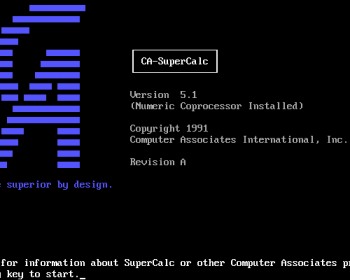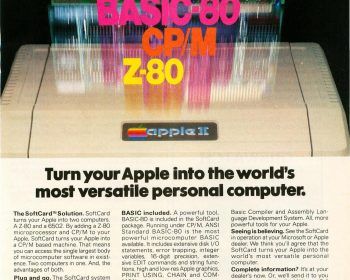Category: 1980
CB Simulator

The very first online chat service was offered by CompuServe and was called the CB Simulator. Released in 1980, the feature used familiar citizen’s band radio concepts to describe its functions such as using “bands” or “channels” to describe the different categories. This quickly became a popular product with virtually…
SuperCalc

In 1980, software company Sorcim introduced SuperCalc, a spreadsheet program with major improvements over VisiCalc. It was able to run on any system that supported the popular CP/M operating system. The Osborne-1 included a free copy of the financial software along with it’s bundle of programs, a big boost to…
Commodore VIC-20
OS/2

In 1980, IBM and Microsoft joined forces. IBM, the venerable computer manufacturer, wanted Bill Gates and Paul Allen, founders of Microsoft, to design an operating system for its PCs. IBM decided to let Microsoft keep the rights to the MS-DOS operating system, allowing Gates and Allen to sell it to…
Philips Electronics

From Philips “History” The foundations for what was to become one of the world’s biggest electronics companies were laid in 1891 when Gerard Philips established a company in Eindhoven, the Netherlands, to manufacture incandescent lamps and other electrical products. The company initially concentrated on making carbon-filament lamps and by the…
Optical Disks

The storage media of most optical storage systems in production today are in the form of a rotating disk. In general the disks are preformatted using grooves and lands (tracks) to enable positioning an optical pickup and recording head to access information on the disk. A focused laser beam emanating…
CB Simulator

The very first online chat service was offered by CompuServe and was called the CB Simulator. Released in 1980, the feature used familiar citizen’s band radio concepts to describe its functions such as using “bands” or “channels” to describe the different categories. This quickly became a popular product with virtually…
SuperCalc

In 1980, software company Sorcim introduced SuperCalc, a spreadsheet program with major improvements over VisiCalc. It was able to run on any system that supported the popular CP/M operating system. The Osborne-1 included a free copy of the financial software along with it’s bundle of programs, a big boost to…
Commodore VIC-20
OS/2

In 1980, IBM and Microsoft joined forces. IBM, the venerable computer manufacturer, wanted Bill Gates and Paul Allen, founders of Microsoft, to design an operating system for its PCs. IBM decided to let Microsoft keep the rights to the MS-DOS operating system, allowing Gates and Allen to sell it to…
Philips Electronics

From Philips “History” The foundations for what was to become one of the world’s biggest electronics companies were laid in 1891 when Gerard Philips established a company in Eindhoven, the Netherlands, to manufacture incandescent lamps and other electrical products. The company initially concentrated on making carbon-filament lamps and by the…
Optical Disks

The storage media of most optical storage systems in production today are in the form of a rotating disk. In general the disks are preformatted using grooves and lands (tracks) to enable positioning an optical pickup and recording head to access information on the disk. A focused laser beam emanating…


